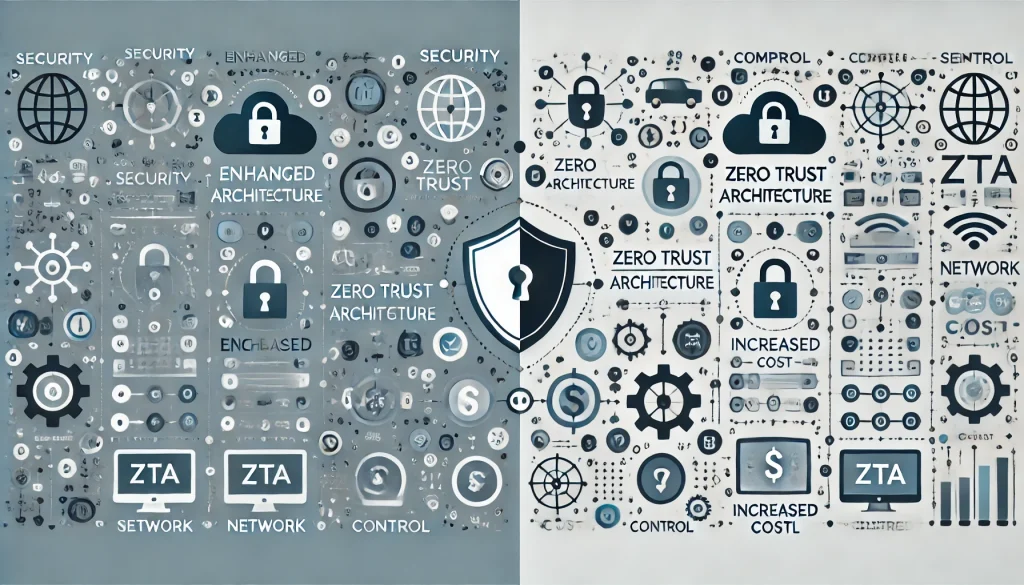Introduction

Zero Trust Architecture (ZTA) is a cybersecurity framework that has gained significant traction in recent years. As the threat landscape grows and cyberattacks become more sophisticated, organizations are turning to ZTA to protect their networks. In this review, we’ll take a closer look at the key aspects of Zero Trust Architecture and examine its strengths and weaknesses to help you decide if it’s right for your organization’s security needs.
Overview
Zero Trust architectures operate on the principle of “never trust, always verify.” Unlike traditional security models that assume everything within the network perimeter is secure, ZTA continuously authenticates and authorizes users and devices. This approach is especially useful in modern, distributed work environments where remote access and cloud services are widely used.
Pros and cons

Pros
- Enhanced security: ZTA enforces strict access controls and continuous monitoring to significantly reduce the attack surface.
- Adaptability: Works well in dynamic environments, such as remote work environments, where traditional security measures may fall short.
- Compliance: Helps organizations comply with strict data protection regulations by ensuring only authorized users have access to sensitive information.
Cons
- Complex implementation: Deploying a zero-trust model can be complex and time-consuming, requiring significant changes to existing infrastructure.
- High cost: The initial setup and ongoing management of a zero trust system can be expensive, especially for small and medium-sized businesses.
- Performance overhead: The continuous validation process can cause latency, potentially impacting the user experience.
Deep dive analytics

Design
The design of a Zero Trust architecture is centered around microsegmentation and strict access controls. This design ensures that even if an attacker breaks into the network, they cannot move laterally to access other sensitive areas. The architecture is built as an adaptive architecture that supports a wide range of devices and users across a variety of environments.
Features
ZTA’s capabilities are robust, providing continuous real-time monitoring and threat detection. ZTA uses machine learning and AI to adapt to new threats and minimize false positives to ensure that legitimate users aren’t unfairly blocked. However, its features are complex and may require specialized skills to manage effectively.
Usability
For end users, the experience of a zero-trust architecture can be a double-edged sword. While security is enhanced, frequent authentication requests can be disruptive. However, when implemented properly, you can balance security and usability by minimizing the impact on usability.
Performance
Performance is a critical factor, especially for high-traffic organizations. While the constant monitoring and verification process can cause latency, advanced implementations of ZTA, such as using AI-driven optimization, can mitigate these issues to some extent.
Compare
When comparing a Zero Trust architecture to a traditional perimeter-based security model, the differences are stark. Traditional models rely on strong perimeters to keep intruders out, but once inside, attackers are free to move about. ZTA, on the other hand, treats every access attempt as potentially malicious and requires constant verification.
Compared to VPN-based security, ZTA provides more granular controls and better protection against insider threats. While VPNs secure your connection, they leave room for potential exploitation because they don’t inherently verify the legitimacy of the user after the initial connection.
Zero Trust architecture vs. traditional security models
| Features | Zero Trust Architecture | Traditional security models |
|---|---|---|
| Security approach | Continuous validation, “never trust” | Perimeter-based, in-network trust |
| Attack surface | Minimize with microsegmentation | A breached perimeter creates a larger attack surface |
| Implementation | Complex and requires an infrastructure overhaul | Easy to implement with existing setup |
| Cost | High upfront and maintenance costs | Lower cost but potentially more vulnerable |
| Adaptability | High adaptability to dynamic environments | Less adaptable, especially when working remotely |
Conclusion
Zero trust architectures provide a robust and adaptable security framework for modern distributed networks. While it can be complex and costly to implement, many organizations are choosing a zero-trust architecture because of the benefits it offers in terms of enhanced security and compliance. For organizations looking to strengthen their cybersecurity posture, investing in a Zero Trust model can be a smart decision.
Evaluation
4.5/5 – Zero Trust architecture is an excellent choice for organizations looking for the highest level of security, but the complexity and cost can be a barrier for some.
FAQ
What is a Zero Trust architecture?
A zero trust architecture is a cybersecurity model that requires continuous verification of all users and devices, regardless of their location within the network.
How does a Zero Trust architecture increase security?
By implementing strict access controls and continuous monitoring, ZTA significantly reduces the risk of unauthorized access and lateral movement within the network.
What are the main challenges of implementing a Zero Trust Architecture?
The main challenges include the complexity of deployment, high cost, and potential performance impact from the ongoing validation process.
See also
- StrongDM. (n.d.). What is zero trust? https://www.strongdm.com/zero-trust
- Palo Alto Networks. (n.d.). What is a zero trust architecture? https://www.paloaltonetworks.com/cyberpedia/what-is-a-zero-trust-architecture
- Roman, R., Lopez, J., & Mambo, M. (2022). On the use of zero trust architecture in distributed and cloud environments. Computers & Security, 120. https://www.sciencedirect.com/science/article/abs/pii/S0167404822003042
- Lopes, N., Apthorpe, A., & Feamster, N. (2022). A survey of challenges and approaches in securing enterprise networks using zero trust. San Jose State University ScholarWorks. https://scholarworks.sjsu.edu/cgi/viewcontent.cgi?article=4381&context=faculty_rsca
- Enterprise Networking Planet. (2023, March 29). Pros and cons of zero trust security. https://www.enterprisenetworkingplanet.com/security/pros-and-cons-of-zero-trust-security/
